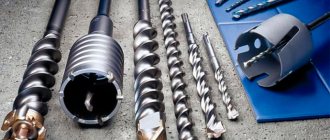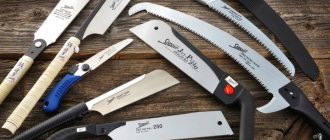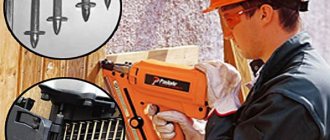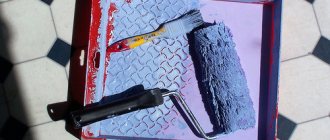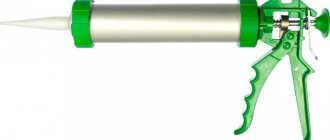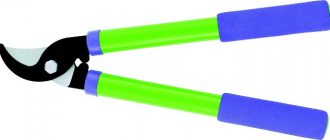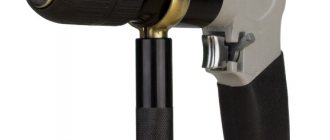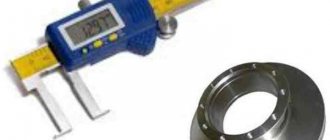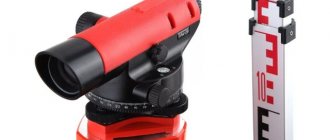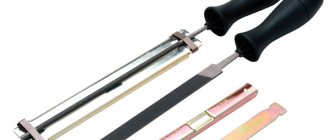One of the simplest and at the same time indispensable hand tools is a spatula. This device is used when performing repair and construction work, and not only by specialists, but also by home craftsmen. When choosing a tool for work, you may encounter such a difficulty as the wide variety of models. Choosing the appropriate spatula option not only improves the quality of the work process, but also saves money, eliminating unnecessary costs. Before you start learning how to use a spatula, you should understand such important issues as, for example, what this tool is intended for and what types there are.
What is a spatula and what is it used for?
A spatula is a construction tool designed for applying adhesive solutions, as well as leveling and decorative mixtures. Structurally, this device is a simple device consisting of the following parts:
- The working area is a wide blade made of stainless steel in accordance with the requirements of state standards.
- Handle - can be located with the blade in the same plane or at a right angle, and is designed to improve the convenience of using the device. The way the handle is positioned affects the technique of using the hand tool. The handle is made of hard plastic, which is rigidly connected to the blade of the tool. There are also tools with handles made of wood, rubber or aluminum.
Most construction spatulas are designed this way, but there are also other models. Their design depends on the purpose, so first let’s look at the issue of the types of tools based on the material they are made of.
Rating
There are both Russian and foreign manufacturers on the spatula market. New models appear constantly, but their structure largely remains the same.
Among the popular companies that produce spatulas are:
- Stayer.
- Cedar Pro.
- Santool.
- Hammer.
- Inforce, etc.
STAYER MASTER 10041-10
STAYER MASTER 10041-10 is equipped with a blade 100 millimeters wide. The blade is made of stainless steel, which increases the service life of the tool. There are no teeth on the blade, which ensures smooth sliding of the spatula over the surface. The two-component handle fits comfortably in the hand while working. The weight of the model is 100 grams.
Valery
Spatel bought it to replace an ancient Soviet model that had become rusty. They are comfortable to work with - the hard blade is easy to clean and does not deform.
Alexey
Instrument does an excellent job with his direct task - putty and plaster. Does not get stuck in the material and washes well.
TOPEX 18B604
TOPEX 18B604 is designed for distributing construction mixtures and cleaning dirty surfaces. All TOPEX products are manufactured in Poland. The tool includes two parts - a stainless steel blade and a two-component handle with an anti-slip coating. The blade width is 40 millimeters. The weight of the model is 90 grams.
Ivan
Spatel is comfortable to hold even without gloves, which happens quite rarely. Forward and reverse grips are equally good. I bought a tool for the brigade and did not regret it.
Nikolay
I bought a spatula for home repairs. The tool is ideal for small jobs. The metal plate is not scratched or stuck.
Top Tools 18B303
Top Tools 18B303 is used for repair and finishing work. It is used in the process of applying gypsum mortar or cleaning surfaces. The tool is equipped with a 30mm blade. The handle is made of wood and the blade is made of metal. The homeland of the brand is Poland, but the products themselves are manufactured in China. The weight of the model is 30 grams.
Pavel
was looking for the most inexpensive spatula for filling the heads of self-tapping screws in drywall and settled on Top Tools. The putty consumption with this tool was moderate, which was important for me.
Denis
Spatula is well suited for driving putty into seams. Due to its small size, it fits into any gap without any extra effort.
SANTOOL 60 mm
SANTOOL 60 mm is designed for applying, leveling and smoothing putty layers. The handle of the tool is made of wood and fits comfortably in the hand due to its ergonomic shape. The varnish coating gives it a smooth finish. The width of the toothless blade is 60 millimeters. The blade is made of steel and is not subject to rust. The weight of the model is 40 grams.
Konstantin
It is convenient to work with a spatula - the blade does not bend under pressure, and the tool itself does not play in the hand. I came across this manufacturer by accident and am completely pleased with the result.
Alexander
I bought a spatula for less than 100 rubles and did not expect much from it. The advantage is the stainless steel fabric. I couldn’t make friends with the tool’s handle—it kept slipping.
FIT 06687
FIT 06687 was developed for applying mortars, sealing seams and cracks. The 125mm stainless steel blade easily distributes any material without getting bogged down. The handle is covered with rubber to prevent slipping in the hand. The two-component handle material allows you to use the tool for a long time. The weight of the model is 120 grams.
Vasily
Inexpensive spatula with average strength. Suitable for home work, but nothing more. An uneven work surface may leave marks.
Vitaly
Spatel is easy to use and does not raise any complaints regarding the quality of work. The only problem with the tool is that it is difficult to wash the handle. In the end there are still stains on it.
HAMMER 238-012
The Hammer Flex 238-012 notched trowel is used for distributing adhesives during the installation of tiles, porcelain tiles and facing stones. The blade is made of spring steel with anti-corrosion coating. The width of the blade is 150 millimeters. The size of the tool tooth is 6x6 millimeters. The handle is made of plastic, painted black. The weight of the model is 100 grams.
Arseny
Thanks to the wide base, the spatula holds a lot of solution. During operation, the surface does not bend.
Vladimir
The smooth, even canvas distributes the glue well. The only thing that bothered me was the presence of dents on the handle. Because of them, the tool is not very convenient to work with.
Inforce 020605-080-300
The Inforce 020605-080-300 notched trowel is used when laying tiles - to distribute and level the working mixture. The 300mm blade is made from cold-worked stainless steel for long-lasting use. The size of the teeth is 10x10 millimeters. The ergonomic plastic handle fits comfortably in the hand and lightens the weight of the tool. The weight of the model is 17 grams.
Mikhail
Despite the low price, the spatula performs well in use. The steel does not bend, the teeth are sharp and do not become dull after a couple of uses.
Vadim
took a spatula to lay floor tiles. The tool was worth the expense - with its help I was able to lay 20 square meters of porcelain stoneware.
Each spatula is designed for a specific type of work. The tool is selected based on several parameters. The surface area, the material being processed and the tasks are taken into account. When buying a spatula, the master pays attention to the shape of the plate, the materials from which it is made and the shape of the handle.
Tool production material
The most popular are metal spatulas, but there are also other varieties. Metal devices are also called universal, as they are suitable for working with different types of building mixtures:
- putty;
- plaster;
- tile adhesive;
- decorative plaster.
For the production of metal spatulas
Stainless steel is used, the advantage of which is its resistance to corrosion. This allows you to increase the service life of the device for a long time. In addition, the working part of the device must have sufficient strength and flexibility, so it is very important to use special alloys that meet these requirements for the manufacture of the product.
In addition to steel, manufacturers also produce plastic spatulas
, which have elasticity and are intended to perform actions such as smoothing or applying materials in a thin layer. They are usually used when gluing wallpaper, when it is necessary to smooth out the resulting folds.
Plastic spatulas can also be used to apply adhesive mixtures or liquid wallpaper, because the main advantage of such products is their gentle effect on the surface being treated. Unlike metal products, plastic spatulas are susceptible to negative effects such as abrasion and scratching, so they do not last long and need regular replacement.
There is another type of tools under consideration - rubber spatulas
. A distinctive feature of such products is their high elasticity parameter. Unlike plastic and metal models, rubber ones can bend depending on the surface topography.
They serve primarily for removing adhesives and sealants protruding onto the surface. The rubber part can have varying degrees of hardness, which can reach the level of plastic products. That is why such spatulas can be used to smooth out folds or apply building mixtures in a thin layer.
How to choose
When choosing a tool, three main criteria are taken into account:
- Plate shape and size.
- Plate material.
- Handle characteristics.
Blade shape and size
Based on the shape of the plate, spatulas are divided into the following categories:
- Straight . The straight edge of the working part is considered the most common due to its versatility. There are models with blades from 2.5 to 25 centimeters. The straight shape is suitable for applying compounds and leveling them.
- Pointed . The sharpened edges are designed to work in hard-to-reach areas. They are used for filling small defects and performing small jobs (such as puttying wooden frames). The width of the plate ranges from 2 to 5 centimeters.
- Serrated . The plates are created to level out adhesive compounds before laying tiles. The teeth evenly distribute even those compounds that differ in their viscosity. The width of the blades reaches 30 centimeters - for working with large areas.
Blade material
Different types of work require blades of varying degrees of flexibility and thickness. The main materials from which the plates are made include:
- Stainless steel . Durable material that is not subject to corrosion. Does not sag under construction mixtures and is not subject to breakage. Spatulas with steel blades are used for working with tile adhesive, removing wallpaper and paint. They are durable.
- Rubber . Rubber blades are used at the finishing stages of finishing. These include applying decorative plaster, grouting the seams of facing tiles and distributing putty along curved areas.
- Plastic . Plastic plates are suitable for final leveling of medium-thick putty. They are also useful when wallpapering - as an aid. This material gently removes air bubbles and excess glue from under the canvas.
What material is the blade of your spatula made of?
SteelRubber
Handle characteristics
The quality of the handle affects the speed of work and its quality. The ease with which the master uses the tool depends on the ergonomics of the handle.
There are three types of handles for spatulas:
- Wooden . Lightweight and durable material, which is often found in budget models. The only drawback of wood is cracking - in case of improper processing.
- Plastic . The quality of plastic handles varies depending on the manufacturer. There are ergonomic and durable options, and there are unreliable and fragile ones.
- Two-component . The handles combine two materials: plastic and rubber/silicone. Rubber inserts are located in places of contact with the palms and fingers. These handles are not subject to rotting or corrosion.
Expert opinion
Torsunov Pavel Maksimovich
Some models of spatulas do not have a handle at all. These include Japanese rubber spatulas. Instead of a handle, there is a compact holder at the base of the tool.
Types of spatulas: classification by purpose
Many novice craftsmen mistakenly believe that a spatula is only intended for applying putty to walls and then leveling it. The defining features of this device depend on its configuration, material of manufacture, size and other technical parameters. If you have to work with a spatula, it is initially recommended to understand the issue of their varieties. After all, the quality of the relevant manipulations depends on this. Let's look at the different types of spatulas below.
Painting spatulas: design, purpose and application
Painting
- one of the most common types of straight blades, which consist of a metal part and a handle made of plastic, rubber or wood. The working part of the painting spatula is made of stainless steel, and its width can vary from 20 mm to 450 mm. The thickness of the blade ranges from 1.5-2 mm, and its shape is often trapezoidal. The main purpose of these types of tools is to complete the final finishing of surfaces: walls or ceilings. These types of finishing often include plastering or puttying.
A paint spatula with a small width is designed for working in hard-to-reach places, for example, when it is necessary to smooth out putty next to a window sill. If work is being carried out to prepare walls for subsequent wallpapering, then for such purposes it is better to use devices with a working part width of 250-350 mm. Typically, devices with a width of 100-150 mm are used in conjunction with the main devices. They serve to collect the appropriate mixtures from a bucket and then distribute them along the blade of the main device. Using two tools together allows them to be cleaned against each other.
Due to the fact that the blade of a paint spatula is very thin, it can bend when applying physical force when smoothing the surface. That is why it is very important to be able to work with such tools correctly. To form a flat plane, you should guide the device so that the edge of the blade is directed at a right angle to tear off.
This is interesting! A paint spatula can be used to remove old wallpaper or a layer of paint. For such purposes, special devices are produced that are distinguished by the presence of a thicker and more durable blade, but painting-type products are also suitable for these purposes.
Criteria for choosing a quality spatula
If you need to choose the most suitable option for a tool, it is not enough to just answer the question of how to hold a spatula correctly; here you have to consider a number of criteria by which such accessories are selected, namely:
- first of all, you have to clarify the cost, since the cheapest accessories are unlikely to meet quality standards;
- you have to choose for yourself the best type of handle, which is easiest to hold in your hand, in order to avoid mistakes;
- it is recommended to take into account what type of work on the surface treatment of the structural element is being performed;
- it is important to take into account the scale of the actions being performed, and also the area of the wall that needs to be processed;
- among other things, you have to pay attention to the blade, which must be completely smooth and elastic.
Special interest will need to be shown in the material that was used in the production of the blade itself, as this has a direct impact on the subsequent durability of the device. Most often, blades for spatulas are made of stainless steel, which makes it quite easy to subsequently clean their surface from frozen excess material.
Facade spatulas and their purpose
If painting products are used primarily for finishing interior work, then façade products are used for finishing facades. The characteristic features of such tools are:
- increased blade elasticity;
- high strength of the handle;
- large blade width - from 200 to 400 mm.
High rigidity of facade spatulas is achieved due to the reduced distance of the blade from the edge to the handle. This parameter plays a very important role, because this type of tool is designed to work with heavy types of building mixtures, which, in addition, are applied in a fairly large layer.
The large blade width plays an important role, allowing you to cover a larger surface area, thereby speeding up the work process. Facade spatulas can also be used for indoor work, for example, when the plane of the room has already been formed and the task is to increase the smoothness of the walls. Due to the large width of the blade, the working process is accelerated many times.
This is interesting! If you are a beginner, it is not recommended to choose facade spatulas with a width of more than 300 mm for work. This will complicate the manipulations of plastering the facade.
Types of spatulas
The spatula is selected based on the tasks it must perform:
- Painting spatulas. This type of spatulas is the most common; they are usually purchased not one at a time, but in a set of two or three pieces, for example, with a small blade width for fine work, a medium blade, more universal, and a wide blade for working with large surfaces. A wide spatula is used to collect a larger amount of solution, and during the work process, the solution is removed from it in portions with a small or medium spatula. The blade width of painting spatulas varies from 20 to 450 mm.
- Spatulas for removing old coatings (scrapers) - paint, wallpaper, etc. Such spatulas are usually equipped with a blade made of thick and durable steel. This type is not very successful, since painting spatulas are also suitable for these purposes.
- Notched spatulas. This type of spatulas is intended for applying adhesive compositions when laying tiles, mosaics, carpet or linoleum, plasterboard and porcelain stoneware. The teeth on the spatula allow you to apply the adhesive more evenly and economically. The size of the teeth is different - small ones are for carpet or linoleum, large ones are for porcelain stoneware or ceramic tiles.
- Facade spatulas. The tool is intended for facade work, that is, with large surfaces, therefore, the blade width of such spatulas can be from 200 to 400 mm. Facade spatulas have a thick and durable blade and a strong handle, this is due to the fact that the solution is applied to the facade in a thick layer.
- Rubber spatula. This type of spatulas has a rubber working surface instead of a steel blade; they are necessary for fine and delicate work. There are three types of spatulas:
- for driving joints between tiles, the blade is made of hard rubber;
- for applying a thin layer of putty, or for applying primer to wooden surfaces, blade made of medium-hard rubber;
- for grouting tile joints, soft rubber blade.
In addition, there are corner spatulas, which we have already talked about, wallpaper spatulas, which are very useful for expelling air from under the wallpaper, and very exotic Japanese spatulas, which are convenient for puttying.
Geared device models: what is the secret of their use
When visiting hardware stores, you probably had to pay attention to spatulas, which are somewhat different from facade models. This difference lies in the design of the working part, that is, the blade. If on a facade device the edge has a flat surface, then on gear models there are cutouts in the form of squares or triangles. This is where the corresponding name came from - notched spatulas, which are also called corrugated spatulas. What these types of devices are intended for, we will consider further.
Due to the presence of teeth on the edge of the tool, the working mixtures are evenly distributed. This is very important when the process of laying ceramic tiles or insulating the facade of a building with sheets of foam plastic or polystyrene is carried out. The use of such tools allows not only to evenly distribute the adhesive mixture on the surface of the material being glued, which is a very important point on which the quality and reliability of the connection depends, but also to save the consumption of the adhesive composition.
Notched spatulas also come in different types. The teeth on the devices are small and large. If devices with large teeth are used to work with ceramic tiles or insulation materials, then products with small teeth are used when laying materials such as carpet, linoleum and mosaic.
Gear devices are not only metal, but also rubber. The use of rubber devices depends on the type of material on the surface of which the adhesive mixture is applied. Many people mistakenly believe that glue must be applied to the surface while holding the spatula at an angle. The tool should be held at right angles to the surface.
This is interesting! When working with plasterboard or porcelain stoneware, it is necessary to use notched trowels with a maximum tooth size of 40x40 mm.
Kinds
Depending on the type of work for which the spatula is intended, this tool is divided into several types:
- Painting.
- Facade.
- Serrated.
- Rubber.
Painting
Painting spatulas are intended for puttying surfaces indoors. Instruments of this type have a trapezoidal shape. They are equipped with a handle that is made at an angle. The material used for the handle is plastic or wood. The plate is usually created from stainless steel.
The jobs for which paint spatulas are used include the following:
- Sealing cracks.
- Surface treatment.
- Giving a special shape to walls or ceilings.
- Filling holes and potholes.
Tools in this group are not intended for working with heavy mixtures. They also cannot withstand collisions with an abrasive surface. The blades are distinguished by their elasticity, but due to their thinness they have increased fragility. The material that paint spatulas are suitable for working with is plaster.
Facade
Facade spatulas are used for both interior and exterior decoration. Their blades are more durable - compared to paint models. The plates are made of high-strength steel, which allows them to be used when working with mixtures with aggressive substances. Facade spatulas are equipped with wide blades for processing large areas. The standard width is from 300 to 600 millimeters.
Facade spatulas perform several main functions:
- Plaster distribution.
- Puttying of vertical and horizontal surfaces.
- Coating various walls with compounds containing heavy mixtures.
Expert opinion
Torsunov Pavel Maksimovich
When choosing a tool, it is important to consider the area on which the work will be performed. Too wide or too narrow can become an obstacle to quality putty. Models whose blades are more than 400 millimeters wide belong to the professional line.
Serrated
A notched trowel is a tool that specializes in distributing adhesives over a tile surface. It is also suitable for working with textured plaster.
The inserts are suitable for processing the following materials:
- Decorative rock.
- Tile.
- Mosaic.
- Porcelain tiles.
- Aerated concrete.
- Styrofoam.
Dental spatulas differ from each other in the width of the plate and the width of the teeth.
The parameters affect what material a particular model works with:
- Teeth 6x6 mm are used for laying tiles 200x200 mm.
- Teeth 8x8 mm are used to work with tiles 300x300 mm.
- 10x10 mm teeth are suitable for laying 300x300 mm tiles with a thickness of 10 mm or more.
Also, the size of the teeth affects the thickness of the adhesive layer. An increase in the teeth leads to a proportional increase in the layer. The most popular models have a tooth height of 6 to 8 millimeters.
Rubber
Rubber spatulas are also divided into groups - soft rubber, painting and grouting. Soft rubber specimens are used for smoothing wallpaper and sealing seams. Painting models are optimal for distributing grout, mastic, thick glue and putty. Grout models are regularly used for grouting joints on linoleum and ceramic tiles.
The class of rubber spatulas is rarely used for putty work. It is also not suitable for grouting stone tile joints. The narrow application of these instruments is due to the soft plate. If handled incorrectly, the material loses its integrity and its further use becomes impossible.
Rubber spatulas have the following advantages:
- A soft effect on the surface that does not leave scratches.
- Rubber easily adapts to the surface and follows its contours.
- A variety of plate shapes - there are rectangles, trapezoids, wedges.
Angle spatulas and their purpose
An experienced builder always has corner types of spatulas in his arsenal, which are a highly specialized type of tool designed for finishing internal and external corners when plastering walls. A characteristic feature of such tools is a blade curved at a right angle. The possibility of using the device for finishing internal or external corners depends on the configuration of the handle. If the handle is directed inside the corner, then such a device is used to align internal corners.
To learn how to use such tools, you will need to practice. After all, the specifics of leveling corners are quite complex, and therefore not even all specialists prefer to work with such devices. They are replaced by ordinary spatulas, which are used in pairs.
This is interesting! Spatulas for external corners are practically not used, since external corners are set using perforated corners.
What is a scraper: what is it intended for?
One type of hand-held device is a scraper, which is used to remove old plaster from the surface before applying a new layer. A tool is used to remove mortar, glue or paint that has hardened on the surface.
To successfully cope with the assigned tasks, the scrapers have a special design. The edge of the blade is well sharpened, which is necessary for effective removal of various frozen solutions. The blade width usually does not exceed 70 mm, which is done specifically to increase the efficiency of the tool. For the manufacture of scrapers, high-strength stainless steel is used, which is resistant to abrasion.
The blade is subject to abrasion as it is used, so it can be sharpened by removing the outermost part of the edge with a file. The design of the spatula in the form of a scraper provides a crescent-shaped recess. It is designed to be used with a hammer to remove difficult contaminants.
This is interesting! There are many different modifications of scrapers that are designed to perform specific actions.
Wallpaper spatula: how to use
When gluing wallpaper, it becomes necessary to use additional tools. This can be a roller, which costs at least 200-300 rubles, or you can use a special spatula. The plastic device is quite effective in removing air bubbles from under the wallpaper, and also aligns them tightly against the wall. That is why wallpaper devices are often called pressing devices.
The wallpaper spatula is made of plastic and is shaped like a wing with an acute angle. It is designed specifically for smoothing wallpaper along the fold line. Manufacturers produce tools in other forms, but which option will be most convenient and comfortable to use can be judged by their practical use.
This is interesting! When choosing a spatula for wallpaper, you need to pay attention to such an important factor as the absence of burrs. The slightest defects on the surface of the spatula will lead to damage to the surface of the decorative items being smoothed during use.
Japanese spatulas - difference from standard models
The Japanese spatula differs from the classic versions in its design. It consists of a working part, to which a holder is attached on the opposite side of the edge. The working part is a rectangular or triangular plate, and the tool is used for processing curved surfaces, finishing and finishing.
The working part can be made of steel and plastic. Steel types of Japanese spatulas are designed for working with flat surfaces, while plastic ones are better suited for processing rounded areas or profile shapes. Typically, tools are supplied not individually, but in a set. The set includes 4-5 devices of different widths, which is very convenient when working with different areas of the surface.
This is interesting! This type of tool is in great demand when carrying out car body work. The device is very convenient for applying putty to metal parts of the body, and allows you to smooth out the composition with high precision.
"Japanese spatula"
A tool specifically designed for applying decorative plaster, such as Venetian. Made from high quality stainless steel. They are not equipped with a handle, but may have a plastic holder on one side of the work plate. This unique design allows for better control over the application of decorative plaster.
A set of “Japanese” from Pavan (Italy).
The plate itself is distinguished by high quality workmanship, a perfectly smooth surface and the absence of the slightest burrs at the edges. As a result, the surface of the decorative plaster is smooth, without tool marks.
Technology for applying Venetian plaster with a Japanese spatula:
- A small amount of decorative mortar is poured onto the edge of the tool and applied to the wall with gentle movements in different directions. The master holds directly onto the metal plate. For best results, the blade should be at an acute angle to the surface being processed.
- A second layer of a different shade is applied to the wall in a similar way and shaded.
- The plaster should now be completely dry.
- After this, wax is applied and the surface is polished with a sponge.
An interesting video on the topic: how to use a Japanese spatula when applying “Venetian”.
Spatulas for suspended ceilings: types of tools
Recently, the method of decorating a room using suspended ceilings has become increasingly popular. Although the design seems simple only after the work, its implementation requires considerable physical effort, as well as the mandatory use of a special tool. These tools include spatulas, which are called “for suspended ceilings.”
Structurally, the devices consist of a handle with a blade, but differ from classical devices. This difference lies in the variety of shapes of the working part - the tips. There are the following types of spatulas for suspended ceilings:
- straight - used to tuck the fabric in hard-to-reach places. Their width does not exceed 20-50 mm;
- curved - these are the most popular types of tools when working with suspended ceilings. Bending angles vary, so devices should be selected depending on the profile of the baguette;
- corner - designed for threading the fabric into the corner parts of the room;
- semicircular - they are used in the case of a specific shape of the baguette profile. The main advantage of the devices is the high speed of filling the canvas into the baguette.
- electric - a type of spatula, through which the movement of the blade or tip is carried out automatically using electrical energy.
The wide variety of tool shapes is due to a number of features of suspended ceilings. If you plan to install a suspended ceiling yourself, then it is important not only to study the step-by-step technology for performing this process, but also to select the necessary types of spatulas and other tools.
Spatulas for sealants: what are they?
There is a special type of tools that are designed specifically to work with adhesives, sealants and silicone. As a rule, such devices have a rubber working part, which eliminates the possibility of damage to the surface on which the substance is applied.
A rubber spatula for sealant is used:
- when grouting joints between tiles;
- when installing plumbing equipment;
- when gluing aquariums, glass and mirrors.
In almost all cases where it is necessary to apply adhesive or sealant to fragile materials, a special type of spatula with a rubber tip is used.
Curly spatulas and their purpose
Few people know that in addition to all the types of spatulas listed above, there is one more variety. It is called a figured spatula, the main purpose of which can be understood from the name. This type of tool is used to form the appropriate relief on putty or paint that was previously applied and did not have time to dry.
The creation of figured reliefs is carried out due to a specific design. Externally, the tool has little in common with classic spatulas. With its help, you can create different types of textures that will imitate wood, stone and other types of materials. The use of a spatula is carried out by applying it to the surface.
To make shaped devices, plastic and rubber are used, and the working part, instead of a sharp edge, has different patterns. The products also come in different sizes, allowing them to be tailored to suit different surfaces.
Tool characteristics
In appearance, a spatula is a spatula made of different materials, equipped with a handle. It is widely used for repair and construction work. With it you can:
- clean old putty, wallpaper and paint;
- apply cement, putty and other solutions;
- putty any surface;
- lay tiles;
- grout joints in brickwork or tiles.
The blade must be rigid and elastic, meet the requirements of the current state standard 10778−83. The tool has several important and standard sizes. In the first place is the width of the device, which, like other parameters, is selected according to the type of finishing work.
Manufacturers produce professional and non-professional models. Professional tools are distinguished by thick blades, they have a good service life, and they do not deform under load. Non-professional devices have a thinner blade complete with a plastic handle.
For narrowly targeted finishing work, special devices are made.
How to use a spatula: instructions for using the tool
The main types of spatulas used in construction and repair work were discussed above. Don't forget that the tools are also used in the kitchen, where they are used to serve confectionery products. Once all types of construction spatulas are known, you should move on to the next stage - learn how to use them. To do this, we will consider the features of using several types of devices that are most in demand.
Tools for putty: using different types of spatulas
Finishing the walls is impossible without a simple but very important construction tool - a spatula. Translated from German, the word “spatula” means “spatula”. Indeed, a tool designed for putty has the form of a spatula, consisting of a handle and a plate or blade.
Types of spatulas for putty
Spatulas are used in a wide variety of construction and repair work; they have different shapes and purposes. The plate of this product can be made of different materials: metal, plastic, rubber. There are special spatulas designed for highly specialized types of work. For puttying walls, flat products with a plastic or wooden handle and a metal plate or, in other words, a blade are most often used.
Facade spatulas
Despite its name, a façade trowel can be used not only for exterior work, but also for interior decoration. It has a wide blade, which is made of high-strength steel and practically does not bend. With this product you can apply building mixtures over large areas. The shape of the working plate is trapezoidal, and the width ranges from 30 to 60 centimeters.
It is convenient to use a façade spatula when plastering walls in conjunction with a paint spatula. When applying a continuous layer of putty with a large tool, you can use a more compact tool to scoop the mixture from the container. During finishing, a large facade spatula can act as an auxiliary one. You can put putty on it, and with the help of a painter, take it in small portions and apply it to the wall.
Painting spatulas
A paint spatula is best suited for finishing walls. With its help the following operations are performed:
- unevenness is smoothed out after applying putty;
- the seams between the sheets of drywall are masked;
- cracks and dents are repaired;
- complex structures are plastered.
Like the façade tool, it has the shape of a trapezoid with a plastic handle. Despite the similarity of design, the painting spatula has the following differences from the facade one:
- Width. The minimum width of the working surface of a painting tool for putty is 2 cm, while facade ones cannot be less than 20-30 cm.
- Thickness. The plate of a painting spatula is usually thinner than that of a facade spatula.
- Elasticity. The blade of the painting tool is more elastic and flexible.
- Material. In the manufacture of painting products, stainless steel is used, while facade products are made of high-carbon steel.
Painting spatulas can be divided into two groups:
- professional;
- unprofessional or disposable.
A high-quality professional tool for finishing walls has a steel thickness of about 1 millimeter, its blade bends moderately and has sufficient rigidity. The disposable product is easy to recognize - it has a black plastic handle and a metal working surface, the thickness of which does not exceed 0.5 mm. It bends at the slightest load; it is extremely difficult to achieve ideal smoothness of the walls with its help, since it repeats all the irregularities.
We recommend: How to make a decorative roller for walls with your own hands
The most common painting spatulas are with a plate having a width of 8 to 45 centimeters. Each craftsman has his own opinion about the most convenient size of tools used, but the most commonly used two products are the following sizes:
- the main instrument, having a width of 20 to 25 centimeters;
- auxiliary, width from 8 to 10 centimeters.
Corner spatulas
There are specialized products for filling internal corners. They have two surfaces located at an angle of 90 degrees to each other. Such tools are not in great demand because they require certain operating skills and even corners in the room. Many specialists stop using special spatulas for corners, preferring to form corners with a regular flat product.
Spatula-scraper
The spatula-scraper has a narrow scope and is designed to remove excess putty from the surface. Its distinctive feature is a thick, rigid blade made of highly durable metal. Its width is small and amounts to 5-7 centimeters.
Using different sized tools
For different stages of wall finishing you need to select tools of appropriate sizes:
- Wide facade or painting spatulas (up to 60 centimeters), as well as the rule (150–300 centimeters) are used on uneven surfaces and allow you to eliminate the roughest and largest defects. With their help, the so-called starting putty of the walls occurs; in this case, the composition is applied in a thick, rough layer.
- Medium ones (from 15 to 25 centimeters wide) allow you to putty large irregularities and dents that remain after passing a wide tool. It allows you to achieve a smooth putty layer. The main task of a medium-sized product is to fill holes. Small protrusions that may remain after it are removed from the dried putty using sandpaper.
- Narrow ones (5–10 centimeters) fill smaller depressions left by a medium-sized spatula. After their work, there are practically no traces left around the individual defect being processed. It is impossible to level the surface using such a product, since it follows all the smooth curves of the wall. Products of this type are also used for puttying hard-to-reach areas. In addition, they can play the role of a typesetting tool - with their help it is convenient to pick up the putty mixture from a container and apply it to a working spatula.
How to choose a quality spatula for putty
A large selection of tools in a hardware store is, of course, good, but, unfortunately, too large an assortment creates difficulties in choosing. In order not to get confused in the variety of spatulas and choose a convenient and high-quality product, you need to pay attention to the following features:
- The handle should fit comfortably in the hand and there should be no nicks or burrs on its surface. The presence of such irregularities indicates low quality of the product.
- Products that are too long are inconvenient, as are products that are too narrow. They will be difficult to handle while working.
- The trapezoidal shape of the product is best suited for putty. Triangular or teardrop-shaped instruments are not as convenient and less reliable.
- A good tool should have a smooth blade with moderate but sufficient flexibility. If, when pressing on the blade, it bends too much, the mixture will fall from such a spatula while working and it will be difficult to even carry it to the wall. Products that are too hard tend to break during operation. When you press on the blade, it should spring back slightly.
- The blade of the finishing putty tool should be made of stainless steel, which will allow it to be easily cleaned after work and will ensure that there is no rust that could ruin the finish.
- A tool with a metal-plated iron blade is a low-quality product and requires especially careful care to prevent corrosion, which can ruin not only the tool, but also the treated surface.
- The blade of the putty tool should not be sharpened. Products with a sharpened blade are intended for other types of work, such as removing old wallpaper, paint and glue from walls.
We recommend: Spray gun for powder painting. Diagram, technology of operation of the sprayer and several examples of such equipment.
How to use a sealant spatula
You can make a spatula for sealant yourself using improvised means, but if you have to work with the device often, then it is better to purchase a factory version. In addition, when purchasing factory spatulas for sealant, you can order them in a set, which will include different configurations.
To understand how to use a spatula for sealant, let's look at the example of the need to seal seams between a bathtub and tiles. This is a fairly common situation that will be of interest to many:
- Initially, the area where the sealant needs to be applied should be thoroughly cleaned, degreased and wiped dry. The effectiveness of the work depends on the quality of preparation.
- After this, you can begin applying the sealant.
- Once a layer of sealant has been applied to the groove between the bathtub and the wall, you must use the appropriate spatula. You need to choose it depending on the angle between the bathtub and the wall. If the bathtub is installed correctly, the angle will be 90 degrees, so choose the appropriate tool.
- Use a spatula from start to finish, pre-cleaning its surface from excess sealant.
- After the first layer of sealant has been removed, all that remains is to complete the final finishing. To do this, it is necessary to moisten the surface of the seam to be treated with soapy water and repeat the procedure of passing with a spatula.
This completes the process of sealing the seams between the bathtub and the wall. Sealing seams using a spatula not only helps to achieve an aesthetic appearance, but also eliminates the occurrence of fungus (blackening of the seams). The seams between window sills and windows, countertops and walls in the kitchen, etc. are processed in the same way. A detailed description of the process for the correct use of a sealant spatula is presented in the video
How to use a notched spatula
If the purpose of a notched spatula is known, then it would seem that it could be difficult to use. However, as practice shows, there are still difficulties. And so that a novice master does not transfer the adhesive solution (which is not cheap for a second) and tiles or other materials, you should first read the instructions. The instructions are not complicated, but they will allow you to correctly install tiles and other building materials. Let's find out how to use a notched trowel correctly using the example of gluing a mosaic to a wall:
- First you need to choose the right type of tool. It is selected depending on the thickness of the building material, which “sits” on the adhesive solution. The height of the spatula tooth should not be greater than the thickness of the building material, in this case the mosaic.
- Having chosen the appropriate type of spatula, we proceed to applying glue to the surface. If it is a hard material, for example, tile, then a layer of glue is applied to its surface. If it is soft, like a mosaic, then the composition should be applied to the wall.
- The surface on which the material is glued must first be covered with soil. Next, a layer of glue is applied, spreading it over the surface. The spatula should be held at a right or slightly inclined angle.
- Next, the adhesive material is applied. To do this, press it tightly to the surface.
- Now we draw conclusions about the correctness of the work done. Between the seams of the mosaic, the layer of glue should not come out. If this is the case, as shown in the photo below, it means that the spatula is chosen correctly, and most importantly, the glue is consumed in the required amount.
The situation is similar with laying ceramic tiles. If you choose the wrong notched trowel, an excess amount of glue will form between the seams, which will need to be removed. This takes time, and besides, the tiles must be immediately washed off the glue. With the right choice of spatula, such disadvantages are eliminated.
Wallpaper spatula: learning to use the tool correctly
If you plan to hang wallpaper yourself, then first you need to stock up on the necessary tools. One of these is a special wallpaper spatula, how to use which we will consider further:
- The wallpaper device does not have a specific shape, which makes it convenient for working with any area. This can be either a flat wall surface or with various protrusions, roundings, corners, etc. A special wallpaper spatula copes with any unevenness better than any device (including a roller).
- The tool is very easy to operate. To do this, you need to lean the strip of wallpaper against the wall or ceiling, then pick up the device and carry out the joining and removal of air.
- The presence of a pointed edge along most of the tool allows you to adjust the wallpaper to ceiling moldings or skirting boards.
The wallpaper spatula is easy to use, unpretentious, and in addition to all the advantages, it is very cheap. It’s much easier to work with than a roller or rags, so if you still don’t know how to glue wallpaper correctly, quickly and efficiently, then it’s time to buy a wallpaper spatula.
Application area
The basic rule is that each stage of finishing work requires its own tool with a certain width of the working part:
- Large spatulas with a wide working area of 250-600 mm are used in the first stage of leveling a wall or ceiling. They are designed for one-time application of a thick layer of plaster mixture. This allows you to quickly level the surface and repair large potholes and chips. Tool work is called “rough” leveling
- Spatulas with a working area width of 150-250 mm are widely used for primary finishing of relatively flat surfaces. A medium-sized tool performs the same operations as a large one, only with less energy. They make it easier for a novice finisher to work
- Spatulas with a narrow working area of 50-100 mm are used for finishing. With their help, small irregularities and chips are repaired, and work is also carried out in hard-to-reach places
Read also: Steel p18 characteristics and application
How to use an angle spatula
If there are no difficulties in leveling the outer corners when plastering the walls, since special perforated corners are used for this, then difficulties arise with the inner corners. And in order to solve these difficulties with maximum efficiency, you should use special corner spatulas. To learn how to work with them, you will need to practice, since the tool has a specific design. To ease the fate of a novice craftsman in the process of leveling internal corners when plastering walls, detailed instructions are provided on how to use a corner spatula:
- The most important thing when working with a tool is to get the hang of how to quickly manipulate it. Plastering walls is a long process, and delay will lead to a slowdown in the pace of work, and as a result, delaying the repair. To prevent this from happening, it is recommended to master the tool.
- There are two ways to start working with an angle spatula. The first method involves applying a layer of putty to the surface of the instrument, after which it is applied to the inner corner. The second method involves first applying the composition to the wall and then passing it along the corner with a spatula for control leveling.
- Before starting work, it is recommended to check the tool for accuracy. To do this, use a square to check the angle ratio and, if necessary, calibrate. The advantage of such a tool is also the fact that it can be used to align not only straight angles at 90 degrees, but also those with various deviations. To do this, you must first adjust the tool and get to work.
The video below shows the process of how to properly use an angle spatula.
Facade models
When it is necessary to work with heavy mixtures, facade devices are usually chosen because of their reliability. Compared to other types of spatulas, these devices are distinguished by their large size and the ability to finish large surface areas.
To buy a spatula, you can decide on the required model by looking at the photo. Particular attention should be paid to the quality of the material and the cost of the device. If you pay attention to the purchase of the device, the work process will be a pleasure.
You must be prepared for construction work in advance, and as a result it is very important that the façade , painting
or other types of tools were purchased in advance.
And, by the way, the types of spatulas can be different, and as a result it is necessary to remember which of them are used for what.
How to choose a spatula?
Many people are sure that there is only one type of spatulas, but they are deeply surprised when they come to the store. In order not to make a mistake, you need to remember what spatulas are and what they are used for. The selection primarily depends on the type of work being performed, but there are several tips that must be followed. For example, it is very important to check how firmly the handle and the plate are connected; there should not be any difficulties, otherwise the tool will simply break during the working period.
Spatulas must be elastic and resilient, which is necessary so that you can easily apply the mixture to the surface for work. Moreover, it is necessary to pay direct attention to what the plate itself is made of: it can be either plastic, or metal, or rubber, and if you buy it from metal, then take only stainless steel.
Moreover, you should make sure that the paint spatula
for the ceiling surface or for the walls was very smooth, without notches, otherwise it will leave streaks during the working period. And remember, the speed and quality of work will also depend on whether you feel comfortable holding it in your hand.
Read also: How to saw off a metal pipe
Selecting a spatula for putty and other work
The video shows an angle spatula
- Painting tool
or
spatula
for sealant.
It is sometimes used as a tool for structural plastering. To put it another way, using its help you will smooth out unevenness after putty or plaster. Such a tool has the usual trapezoid shape, with a comfortable plastic handle, and its working surface is made of high quality stainless steel. One of the very popular sizes is from 20 to 25 centimeters. In this case, it is better to purchase two of them: a key spatula and a spare one. - Angular. It is intended for finishing finishing specifically in the corners of rooms, since the work here is quite difficult, requiring a special tool.
- Facade
.
If we talk about the name, it becomes clear that using its help in most cases they carry out work on external surfaces. The only difference is that in this version a harder and “rigid” material is used, and as a result of this, the spatula
must be of appropriate quality. - Scraper. Intended for removing outdated wallpaper, paint, plaster or putty. It cannot be used for final finishing. Its blade is thicker than a painter’s blade, it does not bend. Not a single preparatory work can be done without it.
- Plastic ( linoleum spatula You can also straighten wallpaper where it cannot be done with a roller.
- Serrated. Used for applying adhesive to tiles. It must be selected naturally with the composition of the solution. So, if, for example, a spatula with small teeth, it can be used for gluing carpet or other floor covering, with large teeth - for applying, for example, glue based on gypsum or other material of similar consistency. However, it is appropriate to note the following here - you must use it only on smooth surfaces, otherwise the application of the solution will be carried out with errors, which may later lead to a quick re-repair.
- Rubber spatula for silicone. It is needed in case there is work to be done on grouting joints or removing excess mortar from the work surface.
- The spatula for seamless ceilings has an oval blade shape and a curved handle for comfortable operation. It is necessary for securing the harpoons of a seamless ceiling. It is worth choosing it very carefully - sometimes it is worth sanding the wooden handles with sandpaper, because... When stretching the ceiling, you have to hold the spatula especially tightly in your hand, and if the handle is poorly executed, you can injure your fingers.
As you can see, a trowel is a key tool in any construction job. And therefore, you do not need to save on purchasing it, because the cleaning of the surfaces and the application of finishing material to them depends on what tool you purchase. If problems arise, always take an interest and ask questions of professionals.
How to use a long facade spatula when plastering walls
Very often, novice craftsmen when plastering walls have many questions about how to properly use a long spatula. In fact, it is no more difficult to work with them than with a regular one with a narrow working part. To understand the principle, you need to know the following:
- When you buy a long spatula, you pay attention to the evenness of its edge.
- It often has a slope in one direction, and therefore many say that this is a defect and the device is not suitable for plastering walls.
- In fact, there is no marriage in this. Even if you managed to find a device with a smooth edge, this does not mean that such a tool is not a fake.
- During the process of plastering the walls, the working edge of the spatula will bend in one of two directions. Moreover, the user needs to pay attention to this from the very beginning of using the tool.
- The photo below shows what the plane of a long spatula should look like. It should have the shape of an arc.
- This is the correct spatula and is ready for use. It is necessary to apply a layer of putty on the wall with the opposite side from the arc. In this case, the putty will lie smoothly, and the corners of the tool will not form grooves.
In order not to peer into the plane of the spatula every time, it is recommended to mark the side with a marker on which the solution should be applied. The solution is applied with a painting device over the entire surface of the working part of the long device, after which the composition is applied to the wall and then smoothed. The video below shows the process of how to properly work with a long spatula.
To summarize, it should be noted that learning to work with different types of spatulas is not difficult. The main thing is to choose the right type depending on the nature of the work. If you do not have experience working with hand tools, then before performing important work, it is recommended to practice in order to master the operation of such a device.
